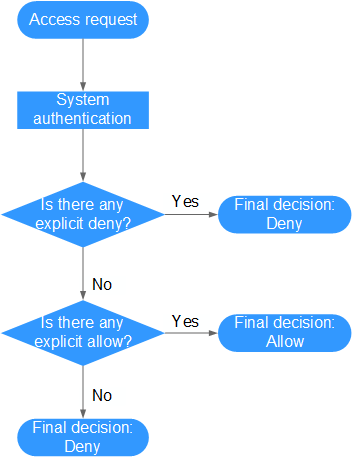Policy Language¶
Policy Content¶
A fine-grained policy consists of the policy version (the Version field) and statement (the Statement field).
Version: Distinguishes between role-based access control (RBAC) and fine-grained policies.
1.0: RBAC policies, which are preset in the system and used to grant permissions of each service as a whole. After such a policy is granted to a user, the user has all permissions of the corresponding service.
1.1: Fine-grained policies. A fine-grained policy consists of API-based permissions for operations on specific resource types. Fine-grained policies, as the name suggests, allow for more fine-grained control than RBAC policies. Users granted permissions of such a policy can only perform specific operations on the corresponding service. Fine-grained policies are classified into default and custom policies.
Default policies: Preset common permission sets to control read and system administrator permissions of different services.
Custom policies: Permission sets created and managed by users as an extension and supplement to system-defined policies. For example, a custom policy can be created to allow users only to modify ECS specifications.
Statement: Detailed information about a policy, containing the Effect and Action elements.
Effect
Valid values for Effect include Allow and Deny. In a custom policy that contains both Allow and Deny statements, the Deny statements take precedence.
Action
The value can be one or more resource operations.
The value format is Service name:Resource type:Action, for example, modelarts:exemlProject:create.
Note
Service name: service name. Only lowercase letters are supported, for example, modelarts.
Resource type and Action: The values are case-insensitive, and the wildcard (*) are allowed. A wildcard (*) can represent all or part of information about resource types and actions for the specific service.
Example Policies¶
A policy can define a single permission, such as the permission to deny ExeML project deletion.
{ "Version": "1.1", "Statement": [ { "Effect": "Deny", "Action": [ "modelarts:exemlProject:delete" ] } ] }
A policy can define multiple permissions, such as the permissions to delete an ExeML version and an ExeML project.
{ "Version": "1.1", "Statement": [ { "Effect": "Allow", "Action": [ "modelarts:exemlProjectVersion:delete", "modelarts:exemlProject:delete" ] } ] }
Authentication Logic¶
IAM authenticates users according to the permissions that the users have been granted. The authentication logic is as follows:

Figure 1 Authentication logic¶
Note
The actions in each policy bear the OR relationship.
A user accesses the system and makes an operation request.
The system evaluates all the permissions policies assigned to the user.
In these policies, the system looks for explicit deny permissions. If the system finds an explicit deny that applies, it returns a decision of Deny, and the authentication ends.
If no explicit deny is found, the system looks for allow permissions that would apply to the request. If the system finds an explicit allow permission that applies, it returns a decision of Allow, and the authentication ends.
If no explicit allow permission is found, the system returns a decision of Deny, and the authentication ends.